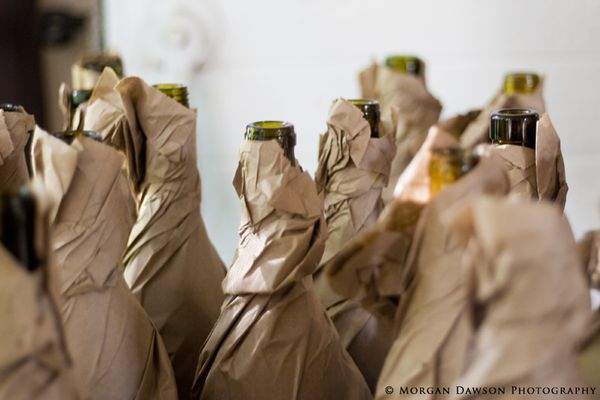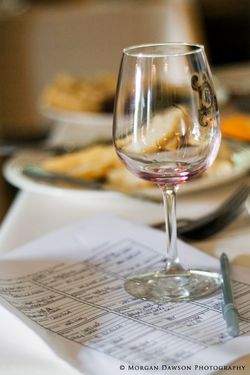
By Evan Dawson, Finger Lakes Editor
Photos by Morgan Dawson Photography
On Wednesday night, on a rain-soaked evening on the southeast side of Seneca Lake, a group of grape growers and winemakers met to taste through a line of 2007 pinot noirs. Many of the wines were made in the Finger Lakes; a few came from the American West Coast, and some from Burgundy.
Tom Higgins, winemaker and owner of Heart & Hands Wine Company, organized the event because he wanted to know: Where does pinot noir stand in the Finger Lakes? Is it truly a recalcitrant mystery, yielding near-constant mediocrity at best? Or is there evidence that the great grape of Burgundy can produce some stunning wines here?
"I think by the end of this tasting we'll have a much better idea of what's going on with pinot in the Finger Lakes," Tom said as the group took shape inside the Stonecat Cafe.
Higgins set out the brown-bagged bottles, numbered 1 through 19, on several long tables. Finger Lakes pinots included those from Heart & Hands, Sheldrake Point Vineyard, Wagner Vineyards, Atwater Estate Vineyards, Dr. Konstantin Frank Vinifera Wine Cellars, Billsboro Winery, Ravines Wine Cellars, Fox Run Vineyards, Damiani Wine Cellars, and Hosmer Vineyard. French wines included two lower-level Burgundies. From the West Coast, one bottle came from the Oregonian producer WillaKenzie and another from Carneros.
For nearly an hour the group tasted and scribbled notes. Some discussed the aromatics and flavors during the tasting; others, including Ravines' winemaker Morten Hallgren, preferred to taste in solace — perhaps to avoid confirmation bias that arises during tasting discussions. Higgins did not ask the group to score the wines.
 When the food arrived, Higgins began to reveal the wines one by one, asking the group first for their impressions. The French wines were duds, sadly; I'd have preferred to shell out a bit more to see how a more pricey Burgundy would have faired. From the West Coast, the Carneros performed surprisingly nicely, due largely to its subtle style that avoided the syrupy extract bombs that so often color the West Coast pinot scene these days.
When the food arrived, Higgins began to reveal the wines one by one, asking the group first for their impressions. The French wines were duds, sadly; I'd have preferred to shell out a bit more to see how a more pricey Burgundy would have faired. From the West Coast, the Carneros performed surprisingly nicely, due largely to its subtle style that avoided the syrupy extract bombs that so often color the West Coast pinot scene these days.From the Finger Lakes, pinot noir proved to be a mixed — but undeniably intriguing — bag.
The local producer that won the most kudos was Damiani, and grower Phil Davis explained that one of the wines (he brought both the 2007 and the 2007 Reserve) was unfiltered and unfined. In fact, the 2007 Damiani Pinot Noir was the cloudiest red wine I had ever seen in a glass, and yet it was seductive and complex. That's no surprise, as Davis keeps yields painstakingly low and brings a passion for pinot that has shown up on other visits to the winery.
The 2007 Ravines Pinot Noir came off as tight as a drum to me, which again was no surprise. I recently drank a bottle of the Ravines 2005 Pinot Noir and it was positively glowing, evolving aromatically over the course of several hours and offering gorgeous length. Winemaker Morten Hallgren called his 2007 "an infant," and I wondered if the table had just committed infanticide.
In fact, as a group I found the 2007 Finger Lakes Pinot Noirs to need more time to properly consider. Most of the industry professionals agreed, and they resolved to try the same flight of 2007 wines again in a year's time. That, I am sure, will be much more instructive. Wagner's Ann Raffetto disagreed, saying that Finger Lakes Pinots need to be drunk young, but she was alone with that opinion.
Other wines of note included the Heart & Hands 2007 Barrel Reserve Pinot Noir, which my wife was able to pick out of the lineup of 19 wines — an impressive feat, and a sign that Higgins is already crafting memorable wines! Fox Run's 2007 Reserve was showing very nicely — I thought it might have been the inspiration for John Mellencamp's song "Cherry Bomb" — but the Fox Run 2007 regular release was disjointed and awkward. "We've experienced some variation," assistant winemaker Tricia Renshaw explained. "There are times we taste the wine and want to get rid of the entire barrel, and at other times it moves in the direction we want to see it go. But certainly it's still a bit young to know for sure." The Dr. Frank 2007 Pinot Noir was greeted favorably, but no one from the winery attended the tasting to explain more about the wine.
Some of the wines were rather bizarre to my taste. I found a strange amount of citrus and pineapple in some, and underripe green notes in a handful of bottles. But this might well come down to cropping, which has been a persistent problem in the Finger Lakes. The best producers are now demanding fewer clusters per vine and lower tons per acre, but some winemakers at the tasting last night admitted they had no idea what kind of cropping was going on. That, to me, is a big problem still.
Noted pinot noir skeptic Dave Breeden, winemaker at Sheldrake Point on Cayuga Lake, was not moved by the tasting. Higgins asked him, at the conclusion of the event, if he had changed his mind regarding Finger Lakes Pinot. "I think I'll keep making riesling," Breeden replied dryly.
But his pessimism is thankfully not shared by the wider group. I wonder why anyone would attempt such a difficult task as making pinot noir in the Finger Lakes if they weren't thrilled by the prospect every morning. Winemakers like Higgins, Hallgren and Renshaw clearly are, as are growers like Phil Davis.
"What I learned tonight is that Pinot Noir has a true personality in the Finger Lakes," Higgins said, clearly satisfied with the results and eager for the challenge ahead. "When it's made here it doesn't show that overbearing jam that you find in other parts of the country. It has elegance and a unique profile. We'd be making a big mistake to give up on it, but we'll need to keep working hard if we want to do it well."
